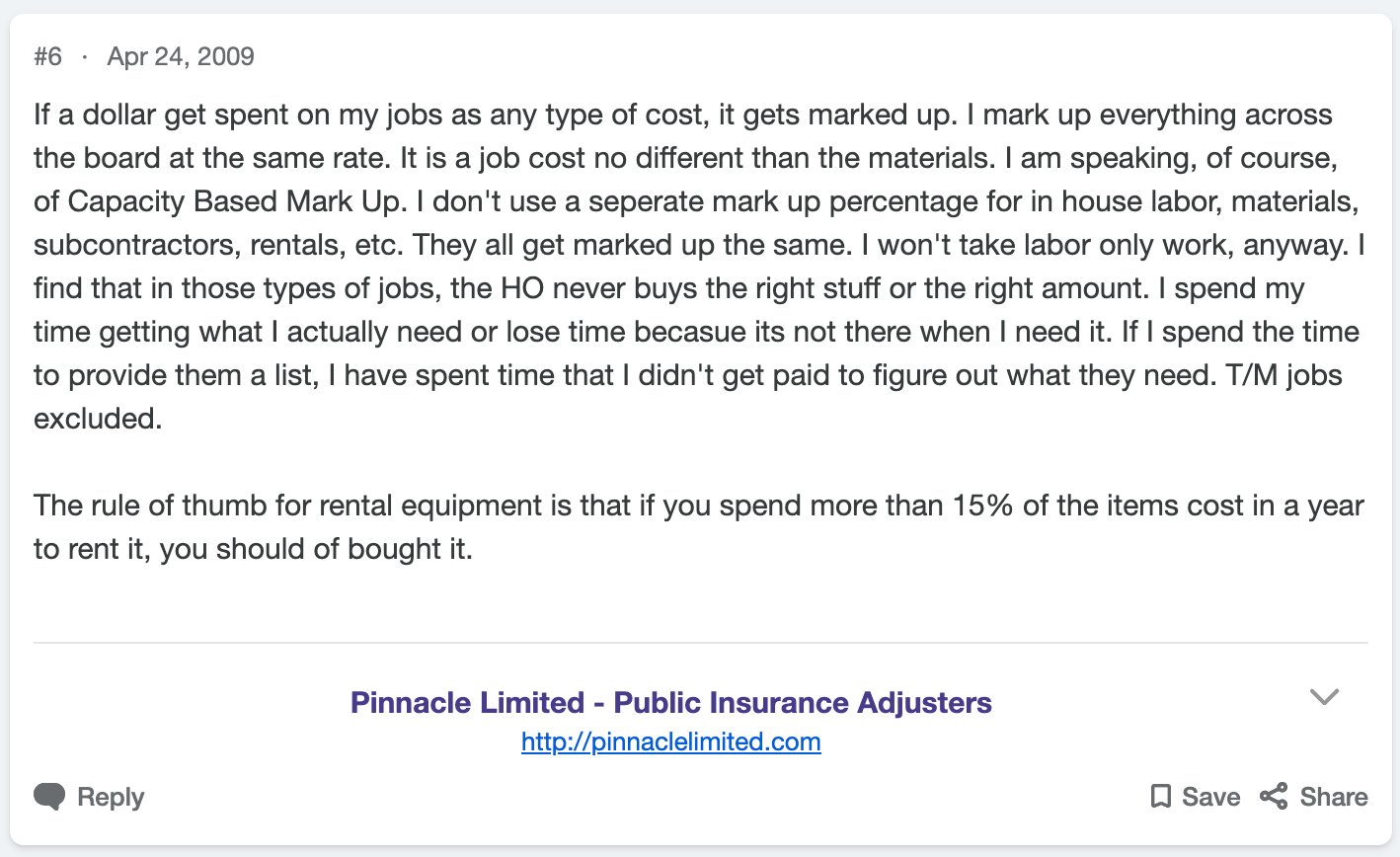Construction business folks: There’s no doubt you’ve heard of the trend. Perhaps you’re even part of it.
Construction companies are renting equipment left and right, breaking the old-school belief that owning is always better than leasing. And according to a study by Fortune Business Insights, this trend will likely stick around for the long haul. In 2018, the construction equipment rental market was worth $98.21 billion—and by 2026, it’s predicted to grow to a whopping $145.22 billion.
If you already lease equipment, you know the pros and cons of renting those pieces of machinery. But what happens when you accept a job that requires something you don’t already have on hand? Should you bill the customer for the new rental cost? Unfortunately, there’s not a simple yes or no answer to that question.
So, let’s hash it out. In this post, we’ll discuss:
- The benefits and drawbacks of passing rental expenses on to clients;
- Whether or not you should mark up those expenses (and if so, by how much); and
- How to account for equipment costs on your invoices.
What are the Pros of Charging Customers for Rental Equipment?
You can make back the money you spent leasing equipment (or even net a small profit).
Renting costs you money. If it didn’t, there’d be no need to charge customers for it. As such, the biggest benefit of billing clients for this cost is that you can break even—or perhaps make a little extra profit.
Many contractors consider rental equipment a job expense like any other. So naturally, they include it as a line item in their quotes. Just keep in mind that doing so may put you at risk of losing a potential client to another bid. Companies that own the equipment don’t usually worry about including it in their job quotes. So if you choose to charge for your machines—especially commonly-owned ones—do your competitive research first.
You can determine whether a certain piece of equipment is worth owning before you commit to buying it.
The more you rent, the more you’ll learn which implements you use most—and consequently, which ones cost you the most money.
In many cases, renting will still be the more cost-effective option. But some contractors rent the same piece of equipment so often that they’d actually save more money in the long run by purchasing it.
Think of renting as a sort of “try before you buy” deal. You’re paying less upfront than you would to own the equipment, and you have time to decide whether it’s worth the full investment.
We’ve all bought things that we rarely use. Renting allows you to sidestep buyer’s remorse and make more strategic budgetary decisions. And charging for rentals allows you to do that with less negative impact to your bottom line.
You can compete for jobs that require uncommon equipment.
If you decide to pass rental costs on to a client, the scarcity of the equipment in question definitely impacts how competitive your quote will be.
Charging customers for equipment that most firms own can (and probably will) cause you to lose bids. But when it comes to obscure apparatuses that even the big dogs don’t have at the ready, the playing field levels out a bit.
As one member of a construction discussion forum mentioned, your location and job type also affect a customer’s willingness to cover rental costs.

If you’re in a less-populated area, you probably already have less competition. Customers may have to accept covering your rental costs in order to get their job done promptly. But the more options they have, the harder it will be to win their business when that extra expense is part of the deal.
What are the Cons of Charging Customers for Rental Equipment?
You’re competing with firms that own the equipment.
The most glaring (and most painful) con of passing rental costs on to customers is that you may be competing with firms that don’t have to do the same. And if the customer is choosing a company based on cost alone, that takes you out of the running pretty darn quick.
As much as we’d like to believe that people are willing to pay for quality, in many cases, it’s a race to the bottom—and those with the lowest quotes will win.
You may need to mark up rental charges to offset risk—and that could make your bids even less attractive.
Owning might be more expensive than renting, but there’s definitely a convenience factor that comes with it. Most rental agreements include a set usage amount as well as scheduled pick-up and drop-off dates. If you need an item longer than expected, the late fees can pile up fast. For this reason, many contractors mark up the rental cost that they pass on to their clients—just in case they need to cover themselves. That drives up costs and makes it even more difficult to compete with companies that own their equipment.
You may end up over-budgeting—and losing potential clients as a result of inflated quotes.
On the other hand, let’s say you reserve a scissor lift for three days, but the job only ends up taking two. Because you over-budgeted, your quote to the customer may not have been as competitive as it could have. In some cases, you may even lose deals due to these types of miscalculations.
Should You Mark Up Rental Equipment?
Okay, let’s say you’ve decided to pass the cost of renting on to a client. What amount should you charge?
Most contractors charge either the same amount they pay to lease the equipment, or a slightly higher amount.
The decision to mark up your rental charge—or not—depends on your specific goals and needs. If you’re trying to make a small profit or cover potential fees, marking up is a must. But if we’re talking about a common piece of equipment that many of your competitors have on hand, inflating this charge can do more harm than good. There’s no black or white answer; it’s a decision you have to make for yourself and your business.
But let’s imagine you do choose to mark up your leased machinery. How much should that mark-up be?
You can use standard rates or adjust on a case-by-case basis.
Markup rates can vary dramatically from business to business, so what is considered the “standard rate” to one might be too low or high for others.
According to Business Econ, the minimum markup is 27%, with most considering a 40% markup to be “reasonable.”
Of course, your markup rate can differ depending on the material and equipment. Or, you can opt for a flat rate, like this contractor who participated in a forum discussion about the topic:

I also know contractors—like the one above—who use established formulas for determining their rate (e.g., Capacity Based Markup).
Over time, rental costs may reveal purchasing opportunities.
If you read the above screenshot again, you’ll see that the last line mentions spending more than 15% of an item’s retail price in rental fees over the course of one year means you should’ve bought it.
This ties back into one of the major pros we discussed earlier: renting gives you the opportunity to “try before you buy.” However, it’s important to remember that “trying” for too long can actually mean spending more money than necessary.
To avoid this, keep track of all the equipment you rent and how often. Ultimately, this is the only way to know whether you should keep leasing or bite the bullet and buy.
So, Should You Pass the Cost of Renting Equipment on to Your Customers?
Now that you’re aware of the pros and cons of charging clients for rental equipment—as well as your options for calculating those charges—it’s time to answer the big question: should you charge customers for rented equipment?
The general consensus is yes, you should. But before you go adding rental line-items to your invoices all willy-nilly, be sure to consider the following:
- Does it (or will it) affect your ability to compete within your market?
- Are you losing business over it?
- Is the equipment you’re charging for common or uncommon?
In the end, only you can decide what’s right for your company. But with these pointers, I’m confident you’re well-equipped (pun intended) to come to your own conclusion.





